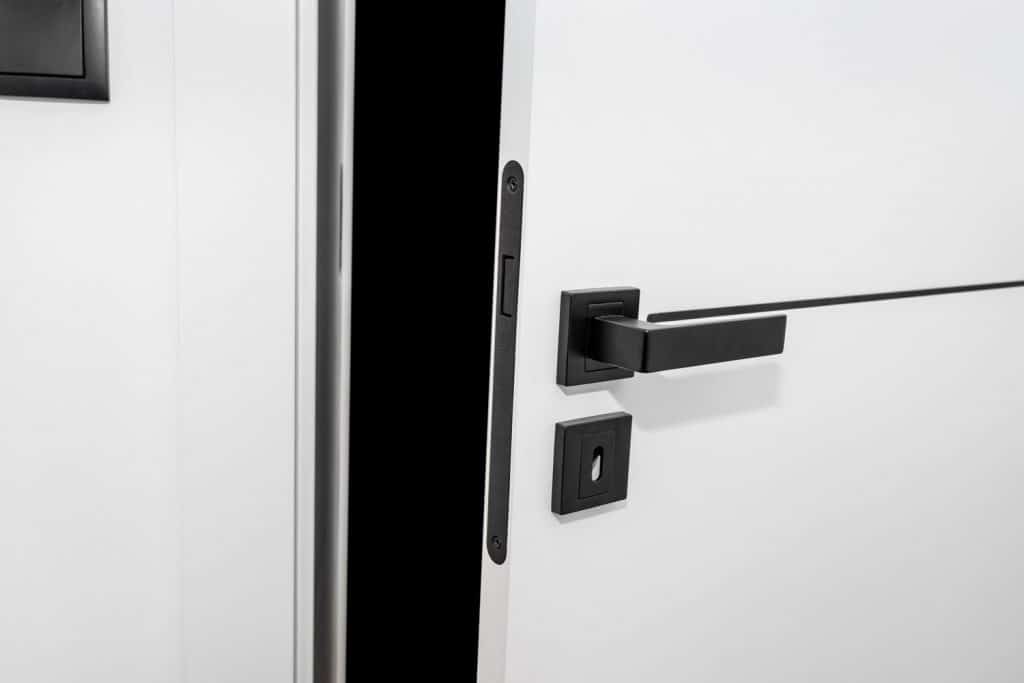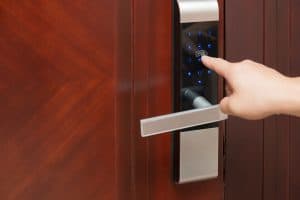Magnetic locks, also known as maglocks, are widely trusted access control devices. Homeowners, landlords, and even companies use magnetic locks since they are some of the strongest, most secure locks in the market. You might be considering getting a maglock but still have some concerns. How much power will the locks use? We have done the research to give you the answers you are looking for.
Magnetic locks use a minimal amount of electricity to operate. Magnetic locks use around 142 watts per hour, which is almost the same as a night light. Looking at the bigger picture, you will see that a magnetic door lock uses only 0.005% of an average home’s daily electric consumption.
Power consumption is one important factor you need to consider before getting a magnetic lock. With that said, you might be wondering if maglocks work without power or if strangers can pick magnetic locks. Continue reading to learn all of these and more about the strength and electrical consumption of magnetic locks.

Magnetic Lock Power Consumption
Magnetic locks are security devices that require constant power to operate or else they unlock. Nevertheless, a magnetic lock’s consistent power use does not mean they generally use a lot of electricity.
A magnetic lock uses 0.142 kWh to operate for 24 hours. This power consumption is similar to an LED night light that uses 0.12 kWh when run for 24 hours.
An average American home uses 893 kWh per month or roughly 30 kWh per day. Consequently, a magnetic lock will only use 0.005% of your daily power consumption.
With all of this taken into account, you can see that adding a magnetic lock to your home can keep you safer while adding a negligible amount to your monthly electric bill and will not add to the financial burden of your household.
How Many Amps Does A Maglock Draw?
Magnetic locks are powered by either 12 volts or 24 volts of direct current and draw 0.5 amperes at 12 volts. When installing, knowing the number of volts and amperes is necessary as mismatching them could break the device or prevent them from working.
If your magnetic door lock fails to keep your door shut, it might be from a voltage mismatch, faulty wiring, or other issues. You can check this article out for more information: Magnetic Door Lock System Not Working – What To Do?
Magnetic door locks work the same regardless of the voltage used, but knowing the voltages and amperages of your devices can help you install the products correctly, especially if you are considering installing multiple locks.
How Does A Magnetic Lock Work?

Magnetic locks work by using two parts: an armature plate attached to the door and an electromagnet attached to the door frame. When connected to a power supply, the magnet generates a pull of up to 2,205 pounds of force.
By using an input method like the press of a button, you can interfere with the current and unlock the door. The magnetic lock can also use fob or card scanners, keypads, and even fingerprints.
Do Magnetic Locks Work Without Power?
Magnetic locks will not work without a constant power supply. This feature of magnetic locks is due to its core concept and design.
A magnetic lock needs to be plugged in at all times since the magnet cannot produce a magnetic force without the use of electricity.
The good thing is that you can use battery backups when you use a magnetic door lock. When you decide to use a battery as an additional power supply in emergency cases, it would be best to check them regularly and replace them when necessary.
A crucial thing to remember is always to consult your authority having jurisdiction (AHJ) before installing battery backups. Using battery backups is acceptable as long as they follow codes and regulations.
Authorities such as the National Fire Protection Association (NFPA) and the International Building Code (IBC) have requirements and proper ways of installing backups on magnetic locks. Such codes are necessary for fire safety and evacuation.
For example, you should not install a fail-safe lock such as maglocks on emergency exits. If a locked door could endanger people’s lives during a power outage, then a magnetic lock would be helpful since it will allow people to escape freely without having to unlock the door every time.
Are Maglocks Fail-Safe Or Fail-Secure?

Because magnetic locks are products that unlock without power, that classifies them as fail-safe locks. On the other hand, fail-secure locks are kept locked when power is removed.
With that said, it would be best to consider a fail-secure lock like an electric strike lock when security is necessary for emergency instances like a power outage.
For example, areas such as vaults, company server rooms, and employee-only rooms can use fail-secure locks to keep them safe when the power goes out.
On the other hand, fail-safe locks are best used on doors that need to be locked but will be used as means of egress in emergencies.
Can Magnetic Locks Be Picked?
Picking a magnetic lock is impossible because lock picking is defined as the act of mimicking a key through the use of tension and instruments. As such, lock picks are of no use when it comes to electric locks.
However, this does not mean that magnetic locks are safe from being bypassed. An easy way that people can bypass magnetic locks is by physically manipulating the electromagnet itself.
For example, a person can stick an object to the magnet to keep it from attaching to the armature plate. This method of bypassing a maglock is easy to spot since all you would need is to check the plate and the magnet now and then.
However, there are more advanced methods of bypassing magnetic locks by tampering with the access control. These bypasses are the paperclip method and the " target="_self" rel="noreferrer noopener">magnet method.
The first method, as shown in the video above, needs a screwdriver to open the keypad or access control. Using a paperclip, a person can then bridge two wires that will send signals for the door to unlock.
The magnet method simply uses a strong magnet to tamper with the relay systems of the access control. By simply placing a magnetic lock at the right spot, a person can instantly open the door. Watch how it is illustrated in this video below:
Although they give complete access to strangers, these methods of bypassing magnetic locks are uncommon. Someone who wants to use these methods of breaking and entering will need to know the model of your access control to know exactly how to open it without causing a scene.
Luckily, there are keypads and access controls that you can install on your locks to prevent unauthorized entry. These access controls often have alarms and anti-tamper systems that trigger when someone tries to bypass your magnetic lock.
To learn more about opening a magnetic lock without a key, you can check out this helpful article: How To Open A Magnetic Lock [Even Without A Key]
In Closing
A magnetic lock can hold a door shut with 2000 pounds of force while using only 0.005% of the daily electric use of an average American home. With all things considered, a maglock is an excellent addition to your home as it provides additional security, all while using an immaterial amount of energy.



